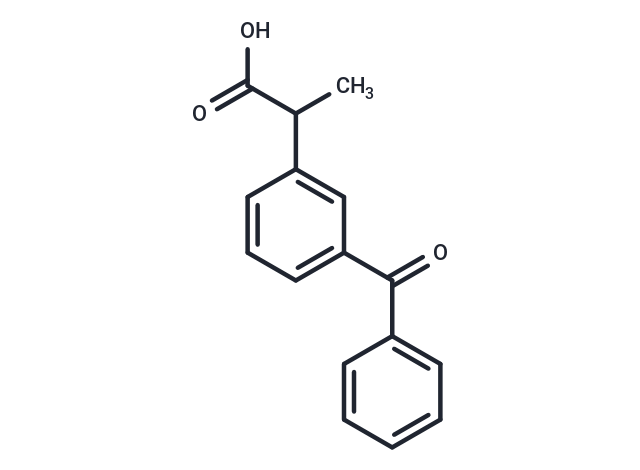 Your shopping cart is currently empty
Your shopping cart is currently empty

Ketoprofen (RP-19583) is a propionic acid derivative and nonsteroidal anti-inflammatory drug (NSAID) with anti-inflammatory, analgesic, and antipyretic effects. It inhibits cyclo-oxygenase I and II, decreasing the formation of prostaglandin and thromboxane precursors. This reduction in prostaglandin synthesis, mediated by prostaglandin synthase, is responsible for its therapeutic effects. Additionally, Ketoprofen decreases thromboxane A2 formation via thromboxane synthase, inhibiting platelet aggregation.

| Pack Size | Price | USA Warehouse | Global Warehouse | Quantity |
|---|---|---|---|---|
| 500 mg | $45 | In Stock | In Stock | |
| 1 g | $53 | In Stock | In Stock | |
| 1 mL x 10 mM (in DMSO) | $50 | In Stock | In Stock |
| Description | Ketoprofen (RP-19583) is a propionic acid derivative and nonsteroidal anti-inflammatory drug (NSAID) with anti-inflammatory, analgesic, and antipyretic effects. It inhibits cyclo-oxygenase I and II, decreasing the formation of prostaglandin and thromboxane precursors. This reduction in prostaglandin synthesis, mediated by prostaglandin synthase, is responsible for its therapeutic effects. Additionally, Ketoprofen decreases thromboxane A2 formation via thromboxane synthase, inhibiting platelet aggregation. |
| Targets&IC50 | COX-2:26 nM, COX-1:2 nM |
| In vitro | Ketoprofen combined with UVB irradiation induces the cytotoxicity and suppresses DNA synthesis in HaCaT cells in a concentration-dependent manner. Ketoprofen combined with UVB irradiation inhibits the cell growth and induces G2/M cell cycle arrest by modulating the levels of cdc2, cyclin B1, Chk1, Tyr15-phosphorylated cdc2 and p21. Ketoprofen combined with UVB irradiation also provokes a striking accumulation of cyclin B1-cdc2-p21 complexes, concomitantly with an increase in the levels of Tyr15-phosphorylated cdc2 and p21 protein. Ketoprofen combined with UVB irradiation accentuates the apoptotic response to UVB radiation in HaCaT cells as evidenced by DAPI staining. [1] |
| In vivo | Ketoprofen at 1% level in suitable topical vehicles can effectively inhibit GCF-LTB4 and GCF-PGE2 and positively alter alveolar bone activity in the ligature-induced model of periodontitis in the monkey. [2] Ketoprofen (3.63 mg/kg bwt) reduces hoof pain andlameness to a greater extent than the 2.2 mg/kg dose and phenylbutazone. [3] Ketoprofen is more effective than local anesthesia (LA), or caudal epidural anesthesia (EPI) in decreasing cortisol and partially reverses the reduction in average daily gain (ADG) following castration. [4] Ketoprofen (40 and 80 mg/kg diet) reduces the incidence of transitional cell carcinoma of the urinary bladder by >70% from that seen in dietary mice. [5] |
| Synonyms | RP-19583 |
| Molecular Weight | 254.28 |
| Formula | C16H14O3 |
| Cas No. | 22071-15-4 |
| Smiles | CC(C(O)=O)C1=CC(=CC=C1)C(=O)C1=CC=CC=C1 |
| Relative Density. | 1.198 g/cm3 |
| Storage | Powder: -20°C for 3 years | In solvent: -80°C for 1 year | Shipping with blue ice/Shipping at ambient temperature. | |||||||||||||||||||||||||||||||||||
| Solubility Information | Ethanol: 48 mg/mL (188.77 mM), Sonication is recommended. DMSO: 250 mg/mL (983.17 mM), Sonication is recommended. | |||||||||||||||||||||||||||||||||||
| In Vivo Formulation | 10% DMSO+40% PEG300+5% Tween 80+45% Saline: 2 mg/mL (7.87 mM), Sonication is recommended. Please add the solvents sequentially, clarifying the solution as much as possible before adding the next one. Dissolve by heating and/or sonication if necessary. Working solution is recommended to be prepared and used immediately. The formulation provided above is for reference purposes only. In vivo formulations may vary and should be modified based on specific experimental conditions. | |||||||||||||||||||||||||||||||||||
Solution Preparation Table | ||||||||||||||||||||||||||||||||||||
Ethanol/DMSO
| ||||||||||||||||||||||||||||||||||||
| Size | Quantity | Unit Price | Amount | Operation |
|---|

Copyright © 2015-2025 TargetMol Chemicals Inc. All Rights Reserved.